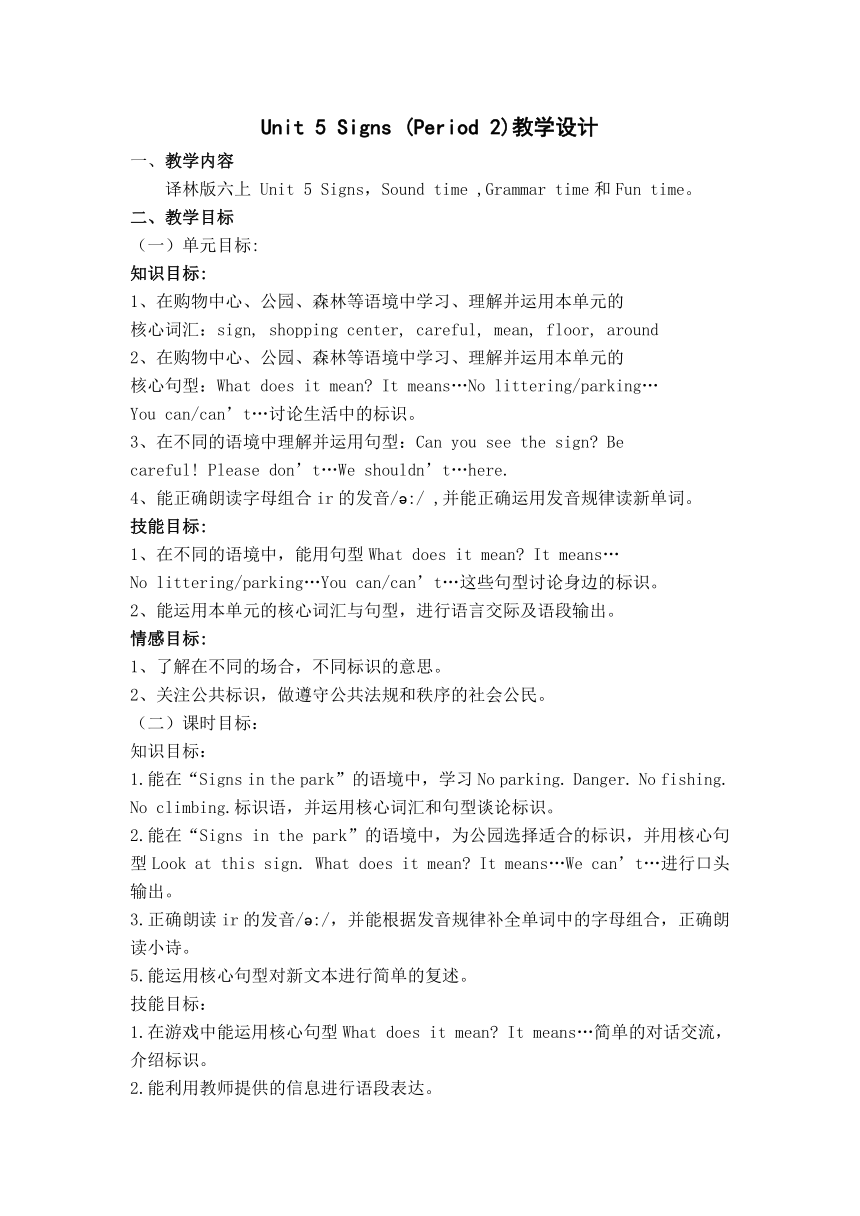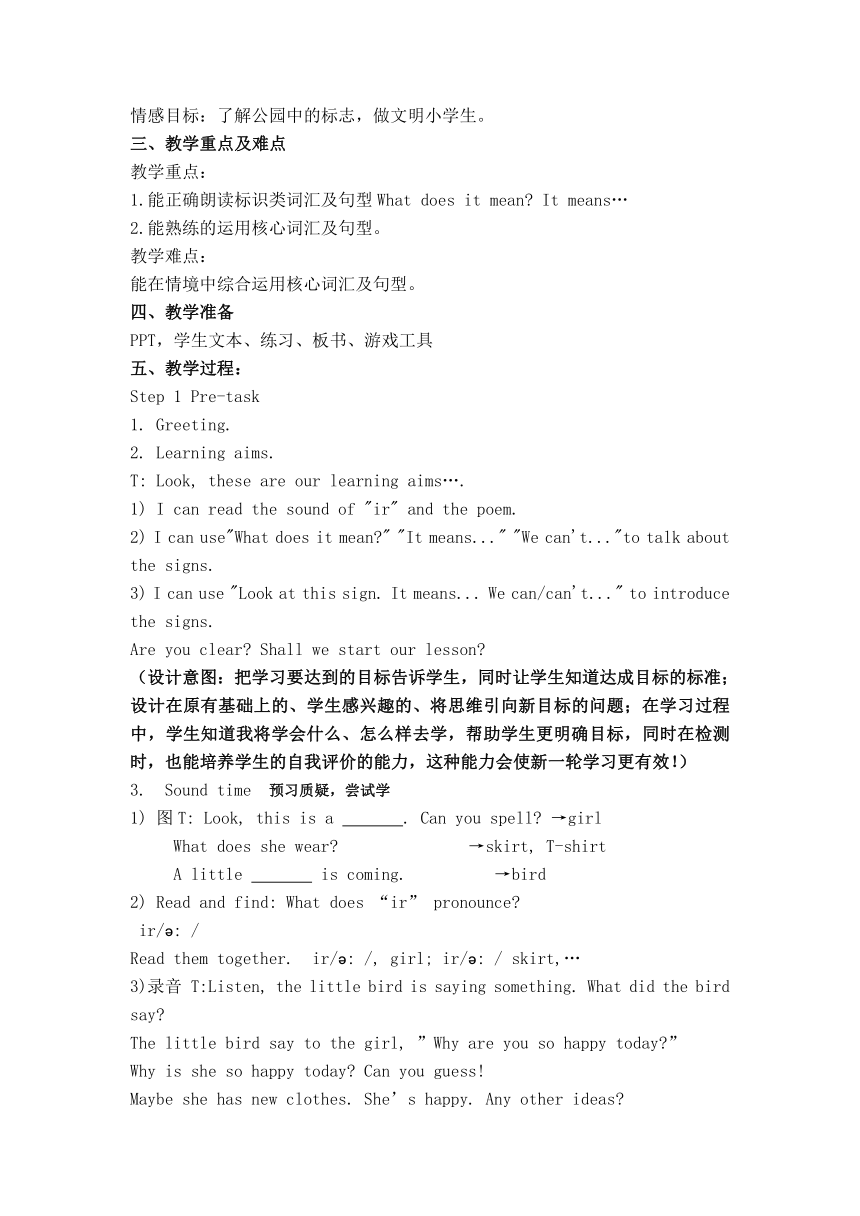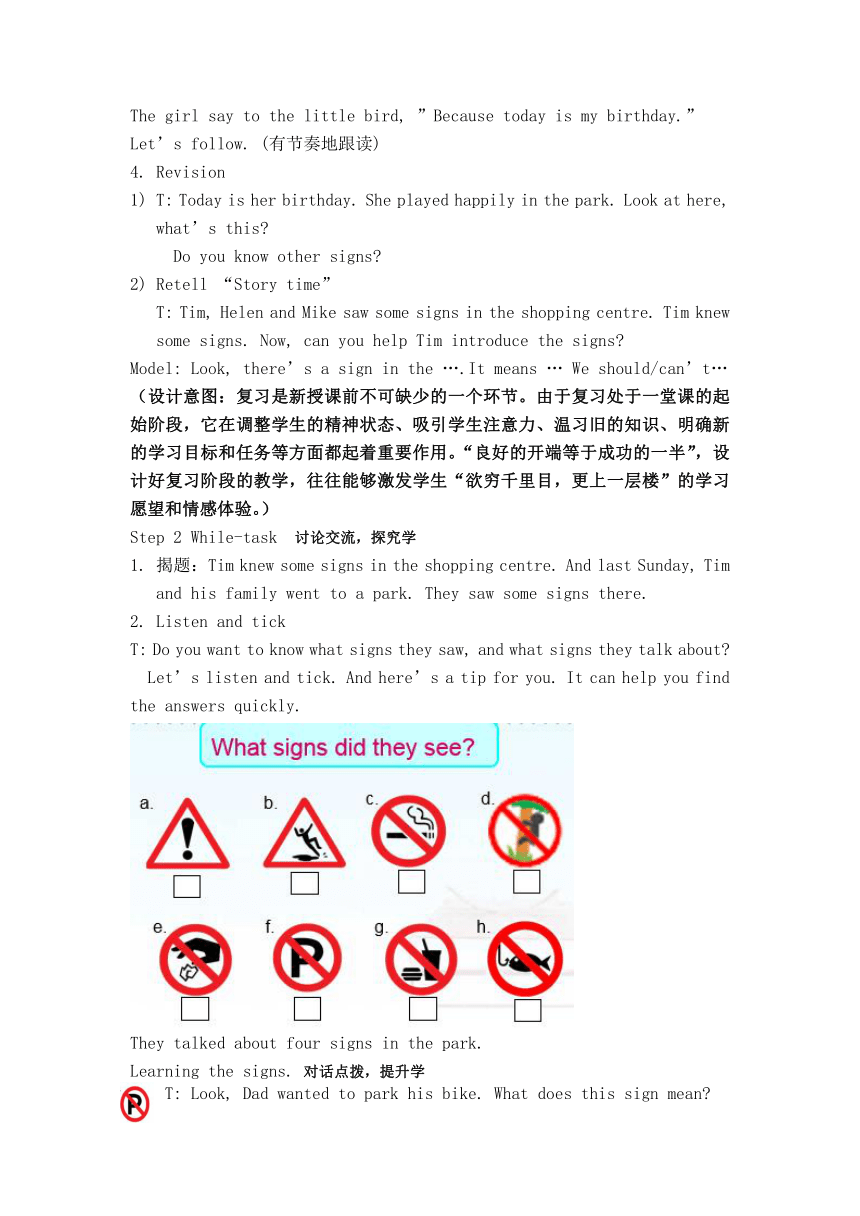Unit5 Signs Sound time &Grammar time&Fun time 教案
文档属性
| 名称 | Unit5 Signs Sound time &Grammar time&Fun time 教案 |  | |
| 格式 | docx | ||
| 文件大小 | 87.9KB | ||
| 资源类型 | 教案 | ||
| 版本资源 | 牛津译林版 | ||
| 科目 | 英语 | ||
| 更新时间 | 2021-12-27 11:18:07 | ||
图片预览



文档简介
Unit 5 Signs (Period 2)教学设计
一、教学内容
译林版六上 Unit 5 Signs,Sound time ,Grammar time和Fun time。
二、教学目标
(一)单元目标:
知识目标:
1、在购物中心、公园、森林等语境中学习、理解并运用本单元的
核心词汇:sign, shopping center, careful, mean, floor, around
2、在购物中心、公园、森林等语境中学习、理解并运用本单元的
核心句型:What does it mean It means…No littering/parking…
You can/can’t…讨论生活中的标识。
3、在不同的语境中理解并运用句型:Can you see the sign Be
careful! Please don’t…We shouldn’t…here.
4、能正确朗读字母组合ir的发音/ :/ ,并能正确运用发音规律读新单词。
技能目标:
1、在不同的语境中,能用句型What does it mean It means…
No littering/parking…You can/can’t…这些句型讨论身边的标识。
2、能运用本单元的核心词汇与句型,进行语言交际及语段输出。
情感目标:
1、了解在不同的场合,不同标识的意思。
2、关注公共标识,做遵守公共法规和秩序的社会公民。
(二)课时目标:
知识目标:
1.能在“Signs in the park”的语境中,学习No parking. Danger. No fishing. No climbing.标识语,并运用核心词汇和句型谈论标识。
2.能在“Signs in the park”的语境中,为公园选择适合的标识,并用核心句型Look at this sign. What does it mean It means…We can’t…进行口头输出。
3.正确朗读ir的发音/ :/,并能根据发音规律补全单词中的字母组合,正确朗读小诗。
5.能运用核心句型对新文本进行简单的复述。
技能目标:
1.在游戏中能运用核心句型What does it mean It means…简单的对话交流,介绍标识。
2.能利用教师提供的信息进行语段表达。
情感目标:了解公园中的标志,做文明小学生。
三、教学重点及难点
教学重点:
1.能正确朗读标识类词汇及句型What does it mean It means…
2.能熟练的运用核心词汇及句型。
教学难点:
能在情境中综合运用核心词汇及句型。
教学准备
PPT,学生文本、练习、板书、游戏工具
五、教学过程:
Step 1 Pre-task
Greeting.
Learning aims.
T: Look, these are our learning aims….
1) I can read the sound of "ir" and the poem.
2) I can use"What does it mean " "It means..." "We can't..."to talk about the signs.
3) I can use "Look at this sign. It means... We can/can't..." to introduce the signs.
Are you clear Shall we start our lesson
(设计意图:把学习要达到的目标告诉学生,同时让学生知道达成目标的标准;设计在原有基础上的、学生感兴趣的、将思维引向新目标的问题;在学习过程中,学生知道我将学会什么、怎么样去学,帮助学生更明确目标,同时在检测时,也能培养学生的自我评价的能力,这种能力会使新一轮学习更有效!)
3. Sound time 预习质疑,尝试学
1) 图T: Look, this is a . Can you spell →girl
What does she wear →skirt, T-shirt
A little is coming. →bird
2) Read and find: What does “ir” pronounce
ir/ : /
Read them together. ir/ : /, girl; ir/ : / skirt,…
3)录音 T:Listen, the little bird is saying something. What did the bird say
The little bird say to the girl, ”Why are you so happy today ”
Why is she so happy today Can you guess!
Maybe she has new clothes. She’s happy. Any other ideas
The girl say to the little bird, ”Because today is my birthday.”
Let’s follow. (有节奏地跟读)
Revision
T: Today is her birthday. She played happily in the park. Look at here, what’s this
Do you know other signs
Retell “Story time”
T: Tim, Helen and Mike saw some signs in the shopping centre. Tim knew some signs. Now, can you help Tim introduce the signs
Model: Look, there’s a sign in the ….It means … We should/can’t…
(设计意图:复习是新授课前不可缺少的一个环节。由于复习处于一堂课的起始阶段,它在调整学生的精神状态、吸引学生注意力、温习旧的知识、明确新的学习目标和任务等方面都起着重要作用。“良好的开端等于成功的一半”,设计好复习阶段的教学,往往能够激发学生“欲穷千里目,更上一层楼”的学习愿望和情感体验。)
Step 2 While-task 讨论交流,探究学
揭题:Tim knew some signs in the shopping centre. And last Sunday, Tim and his family went to a park. They saw some signs there.
Listen and tick
T: Do you want to know what signs they saw, and what signs they talk about
Let’s listen and tick. And here’s a tip for you. It can help you find the answers quickly.
They talked about four signs in the park.
Learning the signs. 对话点拨,提升学
T: Look, Dad wanted to park his bike. What does this sign mean
It means “No parking”. What does “park” mean
When we see this sign, can we park We can’t…
Look and say: A: What does this/that sign mean
B: It means ‘ ’.
We can’t .
(Make a dialogue with “car, bike”)
(设计意图:通过不同的图片的对话结构,让学生巩固、操练句型,并进行口头交流的锻炼。)
Let’s read P1.
T:Good, so can you say like this: There’s a sign…
(2) Then they walked by the lake and saw some boys .Tim said” Hey , please don’t…’
And the boy said “why”
So they saw a sign near the lake. It means…
Tim told the boy we could fish there.
Can you have a try?there’s a …
(3)We know two signs from Tim. Look,can you say the names of the signs
What about these signs
So what can you find
Here’s a tip for you.You can read quietly.
(4) There’re four signs.
Where are the other signs
What do they mean?
Read P3 and P4 by yourselves.
Then complete this form.
Have you got the answers
Let’s look at this sign first.
Do you know ‘Danger’
Look at more signs about “Danger”.
And the last sign.
We can’t climb the tree. It’s dangerous.
(5) So the other signs are…
Let’s try together.
(6)Now, can you have a try
Step3: Post-task.
Talk about the signs. 练习应用,拓展学
T: Tim told us four signs in the park. Look, there are lots of signs .
Can you Talk about the sign with this sentences
A: Look, there’s a sign in/on/near the…
B: What does it mean
A: It means… We can/can’t…
B: Oh, I see.
Play a game.(Fun time)
T: Let’s play a game. Here are the game rules.
So how to talk about the signs (复习句型)
(设计意图:游戏是激发学生的学习动机和他们学习英语的兴趣,培养学生的语言综合能力,使他们轻轻松松接受知识,达到学以致用的目的。)
Introduce your signs
T: Take out your signs. Please introduce your signs.
T: In our life, we can see signs anywhere. They tell us what we can do and what we can’t do. They like a teacher. So, let’s to be a civilized student, obey what the signs say!
(设计意图:让学生介绍自己的标识,发现其标识的共同之处,进行口头输出表达,以此提高英语课堂的学习效率。)
Step 4 Homework
Review all the signs.
Collect more signs and introduce to your friends.
教学反思:
本单元的话题为“公共标识”。在教学过程中要紧密联系生活实际,引导学生关注标识,讨论标识,做遵守公共法规和秩序的社会公民。本单元的新授句型有:What does … mean It means…和No + doing(动名词)结构。前者要求学生灵活运用,后者只需学生认读理解即可。另外,本单元呈现了的情态动词can和can’t的新用法,表示允许和禁止的意思。本板块的内容学生较感兴趣,乐于学习,学生的求知欲强,老师可以将学生置于真实的生活中,让学生课前将自己认识的标识画出来,带到课上和大家一起分享,让学生对本单元的内容充满期待。为了提高课堂教学效率,在教学中我尝试了一下几个方面特色教学。
1.课前导学,突破难点。
上课伊始,通过朗读课堂规则,让学生明白在课堂上不能做什么,既复习了旧知,同时也适时地引出了标志和重点句型:What does it mean It means…的新授,为下一步的学习提前做好有效的铺垫。
2.课堂分层,剖析新文本。
语篇教学一直是我们探讨的话题。故事的学习采用总-分-总的形式,帮助学生理清脉络,把握细节。接着通过细读课文,让学生从文中找出相关句型来给他人提意见,并适时补充一些新的建议,从而使学生扎实有效地掌握所学内容。
3.巧用板书,帮助记忆。
在教学时重点句型时,很多学生只会通过机械记忆,这样效果并不是很好。对于每个标志的含义学生还是不能很快地进行英语描述。为了帮助学生理解记忆,我将一些关键词板书在了黑板上,在上课时发现,果然很多同学能根据个别关键词进行问答。然而还有以部分反映较慢的同学,仍然没有办法很快地流畅问答,于是我灵机一动:为什么不活用我们的课堂板书呢?我先把问题“what does it mean ”写在了课题下面。对于学生易读错的“mean”采用了彩色的粉笔书写,然后再将标志有机的分成两排。将“No smoking”,“No littering”,“No eating or drinking”…等类似的短语放在一起,而将比较特殊的”Keep off the grass”, “Be quiet”,“Danger”等标志放在一起,这样以来块面很清晰,而且有理由引导学生自我思考,自我发现,自我总结规律。
4.激发兴趣,回归生活。
本单元教学中我注重激发学生的学习兴趣,通过设计符合学生生理和年龄特点的活动来丰富课堂教学。如最后的巩固阶段,通过学生游戏,介绍自己的标识等活动,让学生将所学知识达到学以致用,从而能进一步理解这些标记的含义。我还鼓励学生课后寻找生活中更多的英文标记,如No photos, No swimming, No cycling等。通过查找网络资料,使学生进行了充分的语言实践。如此,课堂真正成为学生展示自我的舞台。
纵观整节课的教学,自己教的痕迹还是较重。在课堂上,自己应该放手,让学生有更多思考的机会,更多练习、运用语言的机会,让学生真正成为课堂的主人。
一、教学内容
译林版六上 Unit 5 Signs,Sound time ,Grammar time和Fun time。
二、教学目标
(一)单元目标:
知识目标:
1、在购物中心、公园、森林等语境中学习、理解并运用本单元的
核心词汇:sign, shopping center, careful, mean, floor, around
2、在购物中心、公园、森林等语境中学习、理解并运用本单元的
核心句型:What does it mean It means…No littering/parking…
You can/can’t…讨论生活中的标识。
3、在不同的语境中理解并运用句型:Can you see the sign Be
careful! Please don’t…We shouldn’t…here.
4、能正确朗读字母组合ir的发音/ :/ ,并能正确运用发音规律读新单词。
技能目标:
1、在不同的语境中,能用句型What does it mean It means…
No littering/parking…You can/can’t…这些句型讨论身边的标识。
2、能运用本单元的核心词汇与句型,进行语言交际及语段输出。
情感目标:
1、了解在不同的场合,不同标识的意思。
2、关注公共标识,做遵守公共法规和秩序的社会公民。
(二)课时目标:
知识目标:
1.能在“Signs in the park”的语境中,学习No parking. Danger. No fishing. No climbing.标识语,并运用核心词汇和句型谈论标识。
2.能在“Signs in the park”的语境中,为公园选择适合的标识,并用核心句型Look at this sign. What does it mean It means…We can’t…进行口头输出。
3.正确朗读ir的发音/ :/,并能根据发音规律补全单词中的字母组合,正确朗读小诗。
5.能运用核心句型对新文本进行简单的复述。
技能目标:
1.在游戏中能运用核心句型What does it mean It means…简单的对话交流,介绍标识。
2.能利用教师提供的信息进行语段表达。
情感目标:了解公园中的标志,做文明小学生。
三、教学重点及难点
教学重点:
1.能正确朗读标识类词汇及句型What does it mean It means…
2.能熟练的运用核心词汇及句型。
教学难点:
能在情境中综合运用核心词汇及句型。
教学准备
PPT,学生文本、练习、板书、游戏工具
五、教学过程:
Step 1 Pre-task
Greeting.
Learning aims.
T: Look, these are our learning aims….
1) I can read the sound of "ir" and the poem.
2) I can use"What does it mean " "It means..." "We can't..."to talk about the signs.
3) I can use "Look at this sign. It means... We can/can't..." to introduce the signs.
Are you clear Shall we start our lesson
(设计意图:把学习要达到的目标告诉学生,同时让学生知道达成目标的标准;设计在原有基础上的、学生感兴趣的、将思维引向新目标的问题;在学习过程中,学生知道我将学会什么、怎么样去学,帮助学生更明确目标,同时在检测时,也能培养学生的自我评价的能力,这种能力会使新一轮学习更有效!)
3. Sound time 预习质疑,尝试学
1) 图T: Look, this is a . Can you spell →girl
What does she wear →skirt, T-shirt
A little is coming. →bird
2) Read and find: What does “ir” pronounce
ir/ : /
Read them together. ir/ : /, girl; ir/ : / skirt,…
3)录音 T:Listen, the little bird is saying something. What did the bird say
The little bird say to the girl, ”Why are you so happy today ”
Why is she so happy today Can you guess!
Maybe she has new clothes. She’s happy. Any other ideas
The girl say to the little bird, ”Because today is my birthday.”
Let’s follow. (有节奏地跟读)
Revision
T: Today is her birthday. She played happily in the park. Look at here, what’s this
Do you know other signs
Retell “Story time”
T: Tim, Helen and Mike saw some signs in the shopping centre. Tim knew some signs. Now, can you help Tim introduce the signs
Model: Look, there’s a sign in the ….It means … We should/can’t…
(设计意图:复习是新授课前不可缺少的一个环节。由于复习处于一堂课的起始阶段,它在调整学生的精神状态、吸引学生注意力、温习旧的知识、明确新的学习目标和任务等方面都起着重要作用。“良好的开端等于成功的一半”,设计好复习阶段的教学,往往能够激发学生“欲穷千里目,更上一层楼”的学习愿望和情感体验。)
Step 2 While-task 讨论交流,探究学
揭题:Tim knew some signs in the shopping centre. And last Sunday, Tim and his family went to a park. They saw some signs there.
Listen and tick
T: Do you want to know what signs they saw, and what signs they talk about
Let’s listen and tick. And here’s a tip for you. It can help you find the answers quickly.
They talked about four signs in the park.
Learning the signs. 对话点拨,提升学
T: Look, Dad wanted to park his bike. What does this sign mean
It means “No parking”. What does “park” mean
When we see this sign, can we park We can’t…
Look and say: A: What does this/that sign mean
B: It means ‘ ’.
We can’t .
(Make a dialogue with “car, bike”)
(设计意图:通过不同的图片的对话结构,让学生巩固、操练句型,并进行口头交流的锻炼。)
Let’s read P1.
T:Good, so can you say like this: There’s a sign…
(2) Then they walked by the lake and saw some boys .Tim said” Hey , please don’t…’
And the boy said “why”
So they saw a sign near the lake. It means…
Tim told the boy we could fish there.
Can you have a try?there’s a …
(3)We know two signs from Tim. Look,can you say the names of the signs
What about these signs
So what can you find
Here’s a tip for you.You can read quietly.
(4) There’re four signs.
Where are the other signs
What do they mean?
Read P3 and P4 by yourselves.
Then complete this form.
Have you got the answers
Let’s look at this sign first.
Do you know ‘Danger’
Look at more signs about “Danger”.
And the last sign.
We can’t climb the tree. It’s dangerous.
(5) So the other signs are…
Let’s try together.
(6)Now, can you have a try
Step3: Post-task.
Talk about the signs. 练习应用,拓展学
T: Tim told us four signs in the park. Look, there are lots of signs .
Can you Talk about the sign with this sentences
A: Look, there’s a sign in/on/near the…
B: What does it mean
A: It means… We can/can’t…
B: Oh, I see.
Play a game.(Fun time)
T: Let’s play a game. Here are the game rules.
So how to talk about the signs (复习句型)
(设计意图:游戏是激发学生的学习动机和他们学习英语的兴趣,培养学生的语言综合能力,使他们轻轻松松接受知识,达到学以致用的目的。)
Introduce your signs
T: Take out your signs. Please introduce your signs.
T: In our life, we can see signs anywhere. They tell us what we can do and what we can’t do. They like a teacher. So, let’s to be a civilized student, obey what the signs say!
(设计意图:让学生介绍自己的标识,发现其标识的共同之处,进行口头输出表达,以此提高英语课堂的学习效率。)
Step 4 Homework
Review all the signs.
Collect more signs and introduce to your friends.
教学反思:
本单元的话题为“公共标识”。在教学过程中要紧密联系生活实际,引导学生关注标识,讨论标识,做遵守公共法规和秩序的社会公民。本单元的新授句型有:What does … mean It means…和No + doing(动名词)结构。前者要求学生灵活运用,后者只需学生认读理解即可。另外,本单元呈现了的情态动词can和can’t的新用法,表示允许和禁止的意思。本板块的内容学生较感兴趣,乐于学习,学生的求知欲强,老师可以将学生置于真实的生活中,让学生课前将自己认识的标识画出来,带到课上和大家一起分享,让学生对本单元的内容充满期待。为了提高课堂教学效率,在教学中我尝试了一下几个方面特色教学。
1.课前导学,突破难点。
上课伊始,通过朗读课堂规则,让学生明白在课堂上不能做什么,既复习了旧知,同时也适时地引出了标志和重点句型:What does it mean It means…的新授,为下一步的学习提前做好有效的铺垫。
2.课堂分层,剖析新文本。
语篇教学一直是我们探讨的话题。故事的学习采用总-分-总的形式,帮助学生理清脉络,把握细节。接着通过细读课文,让学生从文中找出相关句型来给他人提意见,并适时补充一些新的建议,从而使学生扎实有效地掌握所学内容。
3.巧用板书,帮助记忆。
在教学时重点句型时,很多学生只会通过机械记忆,这样效果并不是很好。对于每个标志的含义学生还是不能很快地进行英语描述。为了帮助学生理解记忆,我将一些关键词板书在了黑板上,在上课时发现,果然很多同学能根据个别关键词进行问答。然而还有以部分反映较慢的同学,仍然没有办法很快地流畅问答,于是我灵机一动:为什么不活用我们的课堂板书呢?我先把问题“what does it mean ”写在了课题下面。对于学生易读错的“mean”采用了彩色的粉笔书写,然后再将标志有机的分成两排。将“No smoking”,“No littering”,“No eating or drinking”…等类似的短语放在一起,而将比较特殊的”Keep off the grass”, “Be quiet”,“Danger”等标志放在一起,这样以来块面很清晰,而且有理由引导学生自我思考,自我发现,自我总结规律。
4.激发兴趣,回归生活。
本单元教学中我注重激发学生的学习兴趣,通过设计符合学生生理和年龄特点的活动来丰富课堂教学。如最后的巩固阶段,通过学生游戏,介绍自己的标识等活动,让学生将所学知识达到学以致用,从而能进一步理解这些标记的含义。我还鼓励学生课后寻找生活中更多的英文标记,如No photos, No swimming, No cycling等。通过查找网络资料,使学生进行了充分的语言实践。如此,课堂真正成为学生展示自我的舞台。
纵观整节课的教学,自己教的痕迹还是较重。在课堂上,自己应该放手,让学生有更多思考的机会,更多练习、运用语言的机会,让学生真正成为课堂的主人。
